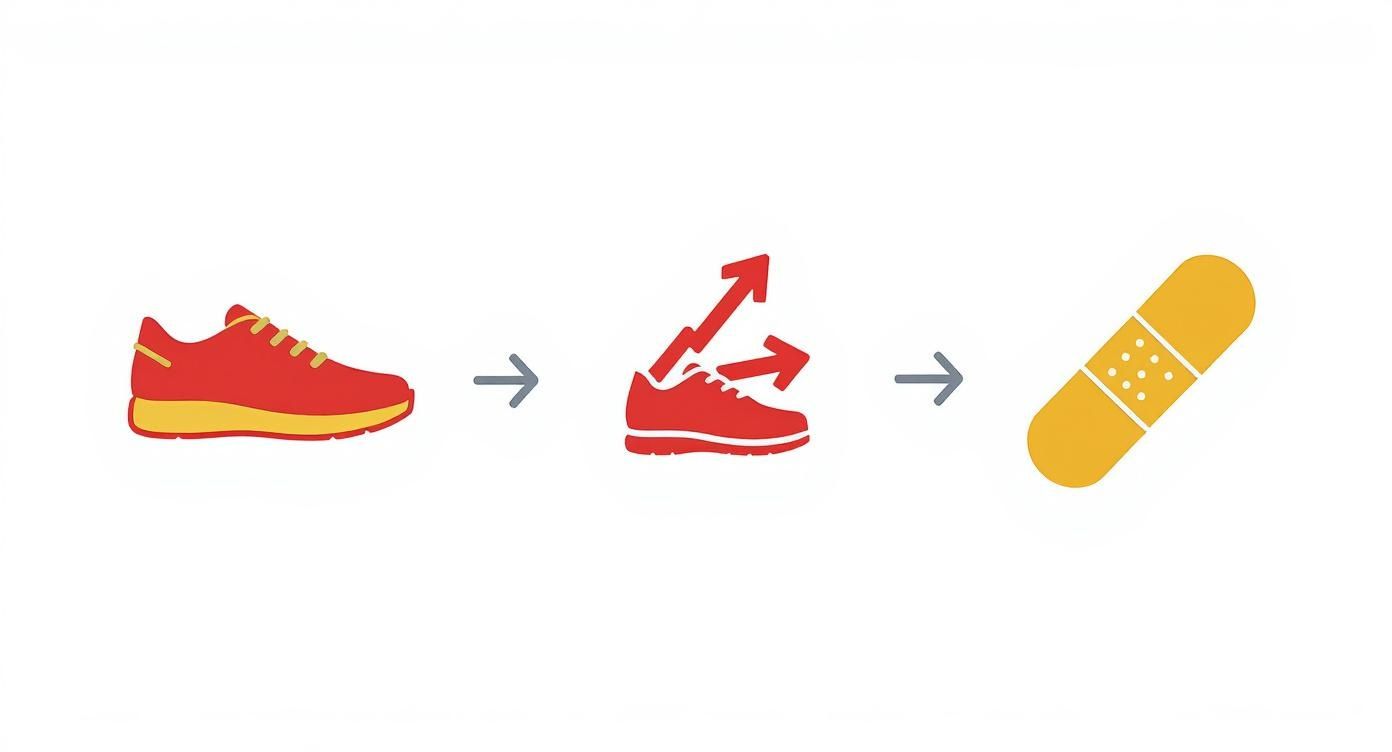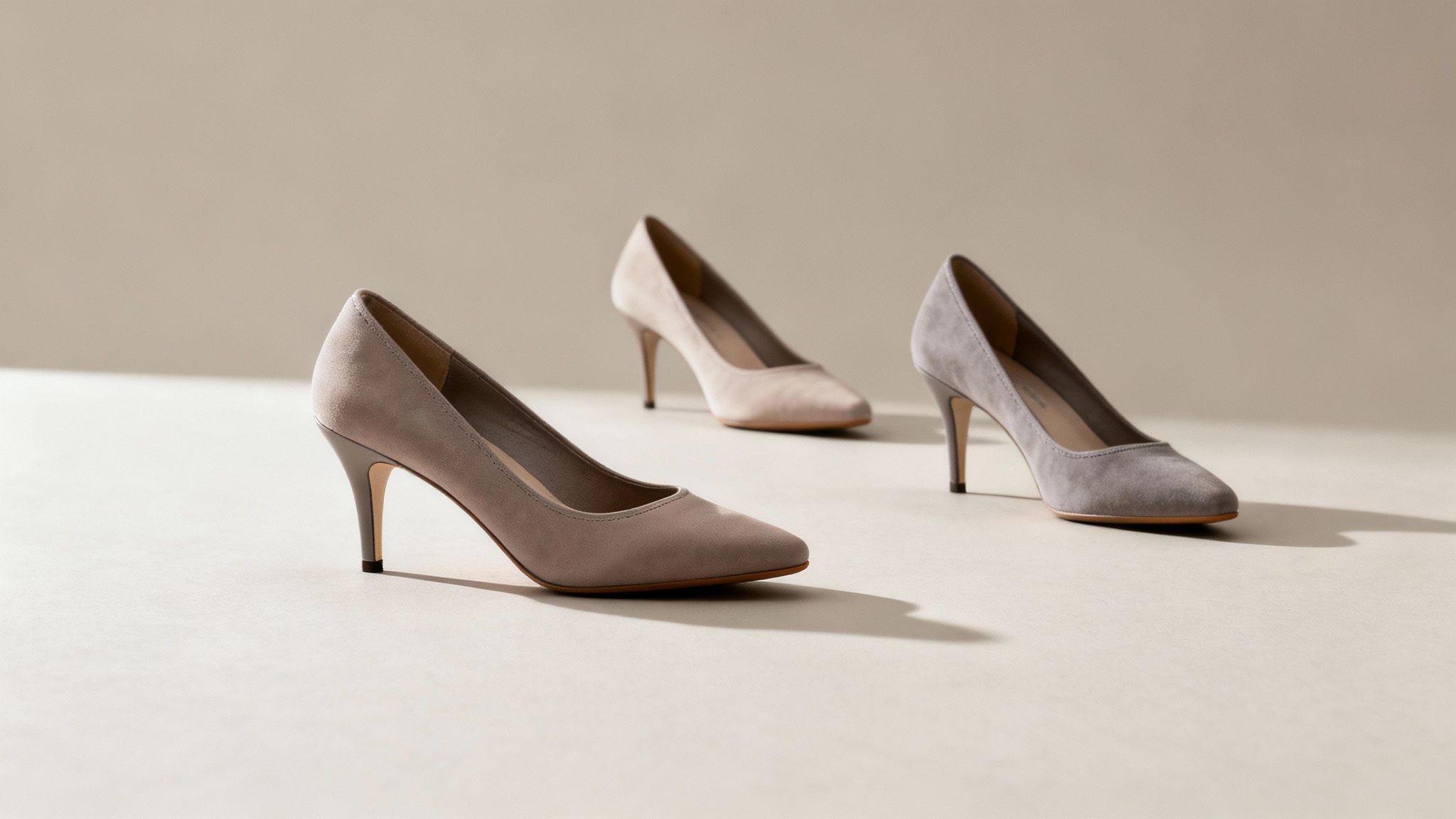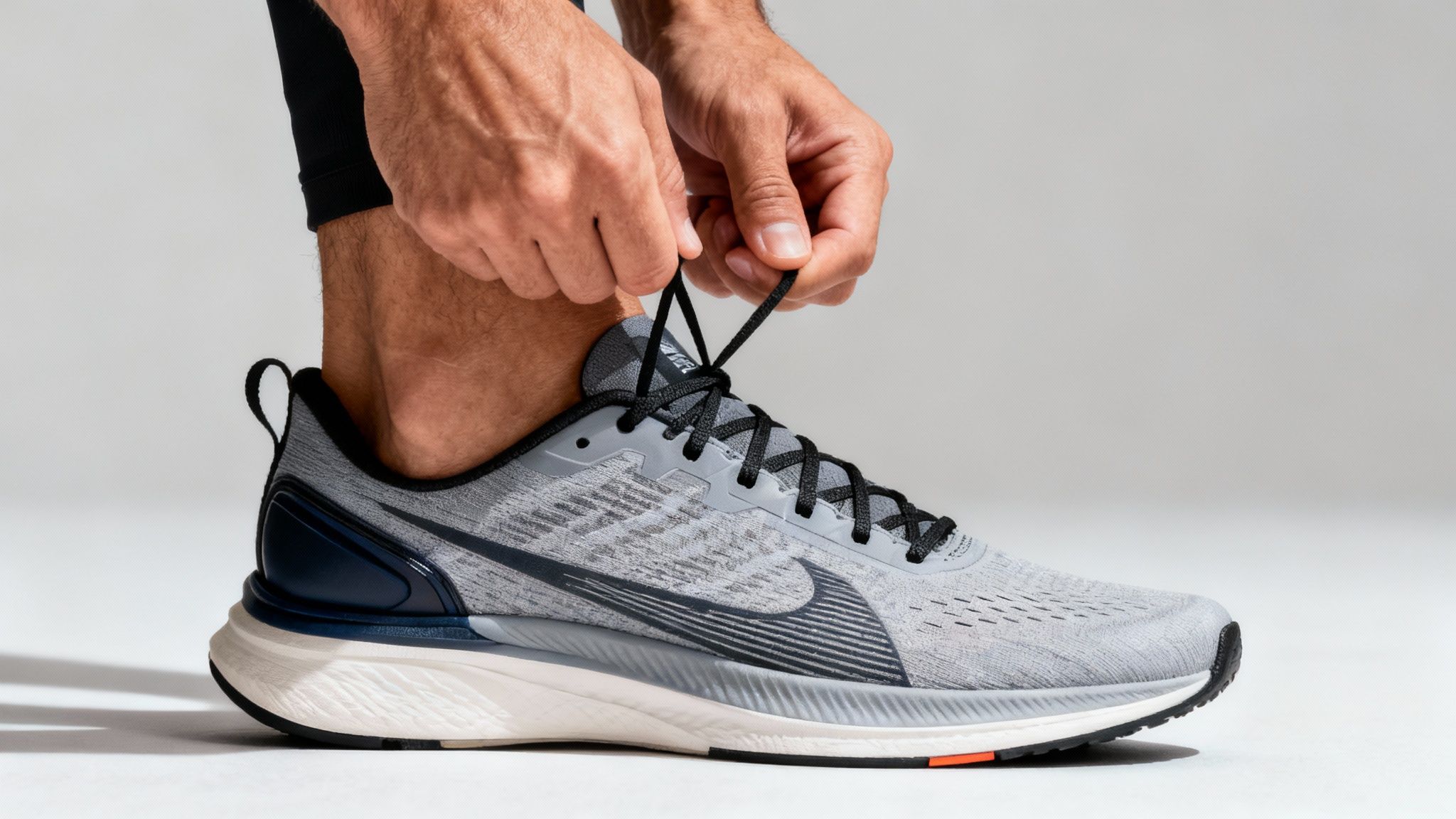Best running shoes for narrow feet: Top Picks & Fit Guide
- Flourish Everyday Health And Fitness
- 21 minutes ago
- 9 min read
Heel slippage, blisters, and that wobbly, unstable feeling—sound familiar? If you have narrow feet, finding the right running shoe isn't just about comfort; it's about performance and preventing injury. The goal is to find a pair that feels less like a shoe and more like a natural extension of your foot.
This guide will walk you through exactly what to look for, from determining your true foot width to identifying key shoe features. We'll review top models for both men and women, ensuring you have the confidence to find a pair that fits perfectly.
Table of Contents
Your Guide to a Perfect Fit
Searching for running shoes for a narrow foot can be frustrating. A standard-width shoe leaves too much space, allowing your foot to slide. This movement causes blisters and forces the small stabilizing muscles in your feet to work overtime, leading to fatigue and potential injury. The solution is finding a shoe built on a narrower last—the 3D mold a shoe is constructed around—for a truly secure feel. For a broader look at shoe selection, our expert guide offers foundational knowledge on Flourish-Everyday.com.
Key Features to Prioritize
When hunting for running shoes for narrow feet, a few features are non-negotiable. Focusing on these elements will improve your chances of finding a shoe that delivers comfort and performance. A great fit is about the shoe's internal volume matching your foot's shape.
A snug fit is essential for efficient running mechanics. A secure foot achieves better power transfer, reducing wasted energy and improving running economy.
Here is a summary of what to look for in a running shoe for narrow feet.
Key Features of Running Shoes for Narrow Feet
Why the Right Shoe Width Is a Game Changer
Wearing running shoes that are too wide is like driving with a loose steering wheel—it creates instability with every step. For runners with narrow feet, proper shoe width is critical for stability, efficiency, and injury prevention.
When a shoe is too wide, your foot slides around. This forces the tiny muscles in your feet and ankles to work overtime to create stability.
The Ripple Effect of a Poor Fit
This extra muscle work wastes energy. Instead of propelling you forward, effort is spent keeping your foot stable. This can tire muscles quickly, from your feet to your calves and shins. This instability can lead to common running injuries as stress isn't distributed evenly.
Plantar Fasciitis: An unstable arch puts strain on the plantar fascia.
Achilles Tendinitis: Heel slippage causes friction and stress on the Achilles tendon.
Shin Splints: Lower leg muscles work harder to prevent your foot from slapping down.
Blisters and Calluses: These are the first signs of a bad fit, caused by friction.
Unlocking Performance with a Secure Lockdown
Conversely, a running shoe that fits your narrow feet is a game-changer. When your foot is held securely, the shoe becomes an extension of your body, achieving a good "lockdown." A solid lockdown means better power transfer. Every bit of force propels you forward, with no wasted motion. This improves your running economy. For practical advice, some blogs offer great tips, like the guide on Breezing Through. The right shoe width is a critical piece of gear that protects your joints and lets you run with more power.
How to Accurately Measure Your Foot Width
Before buying new running shoes, get your exact measurements. Guessing or using an old size leads to shoes that slip and cause problems. An accurate measurement is your roadmap to a secure, comfortable fit. You can easily do this at home.
The Trace and Measure Method
The most reliable way to measure your feet at home is the trace-and-measure method. You'll need paper, a pen, and a ruler.
Prepare: Place paper larger than your foot on a hard, flat surface.
Trace: Wearing your usual running socks, stand on the paper. Hold the pen perpendicular and trace your foot's outline.
Mark: Find the broadest part of your forefoot on the tracing and draw a straight line connecting these points.
Measure: Measure the length of that line. Repeat for your other foot, as feet are often different sizes.
Decoding Sizing and Common Pitfalls
Compare your measurement to a brand's sizing chart. Shoe width is shown with letters. For women, a narrow width is 2A or AA; B is standard. For men, a narrow width is B; D is standard.
Avoid these common mistakes for an accurate measurement:
Measuring Too Early: Measure in the late afternoon or evening when your feet are at their largest.
Sitting Down: Stand with your full body weight on your foot for a true tracing.
Forgetting Socks: Always measure with your running socks on.
The image below shows how a wide shoe leads to instability and potential injury.

This is why matching shoe width to your foot is so critical. Podiatric studies now estimate that up to 40% of people may need narrow shoes to avoid issues like blisters and joint pain from a poor fit. You can find more insights on shoe fit from the American Academy of Podiatric Sports Medicine at www.aapsm.org.
Top Running Shoes for Women with Narrow Feet
Finding a running shoe that hugs a narrow foot properly is a challenge. The key is to look for brands offering true narrow-width options, usually labeled 2A or AA. These are built on a slimmer foundation for a secure, low-volume fit.

The women's running shoe market has grown significantly, indicating a demand for shoes that cater to specific foot shapes. You can get more details on market trends at RunRepeat.com. The shoes highlighted below are from brands that create exceptional narrow-fit options.
Brooks Ghost 16: The Reliable Daily Trainer
The Brooks Ghost is a legendary neutral daily trainer, balancing soft cushioning with a responsive feel. Its availability in a 2A width makes it ideal for narrow feet. The Ghost's standout feature is its incredible heel and midfoot lockdown. The engineered air mesh upper wraps the foot snugly, and the structured heel counter prevents slippage.
Cushioning: DNA LOFT v3 foam provides a soft, protective ride.
Best For: Daily training, long runs, and recovery days.
Fit Profile: True to size, providing a secure, structured feel in the narrow width.
New Balance Fresh Foam X 880v14: The Versatile Workhorse
New Balance excels at offering various widths, and the 880v14 in narrow (2A) is a prime example. This shoe is a dependable, do-it-all neutral trainer. The 880 combines a secure upper with a balanced midsole. The Fresh Foam X cushioning is soft but not mushy, and the hypoknit upper provides a structured, breathable wrap that locks down the midfoot.
The 880v14 is like that trusted running partner who always shows up—consistent, reliable, and supportive. It's a no-fuss shoe for runners who just want something that works.
Saucony Guide 17: The Modern Stability Option
For women with narrow feet who overpronate, the Saucony Guide 17 is a game-changer. Saucony has rethought stability, using a holistic system that centers the foot. The Guide 17 uses a broader base and raised sidewalls to gently guide your stride, an effective approach in a narrow fit. This CenterPath Technology provides support without being intrusive.
Here’s a quick look at what makes it stand out:
Top Running Shoes for Men with Narrow Feet
For men with narrow feet, finding a shoe that locks the foot down is key. The goal is the elusive B width, which is built on a narrower last to reduce the shoe's volume for a custom-like fit.

A precise fit is crucial in disciplines like trail running, where a snug fit prevents sliding on uneven ground and is essential for stability. You can dig into more trail running shoe market trends to see just how critical fit is. Let's look at standout models for men needing a narrower fit.
Asics GEL-Kayano 31: The Premier Stability Choice
The Asics GEL-Kayano is a legendary stability shoe. For men with narrow feet who overpronate, the GEL-Kayano 31 in a B width offers a secure fit. Asics' 4D GUIDANCE SYSTEM™ provides adaptive stability that works with your foot's natural movement.
Midfoot Lockdown: The engineered mesh upper and lacing create a snug wrap where it's needed most.
Cushioning: FF BLAST™ PLUS ECO cushioning with PureGEL™ technology results in a soft and energetic ride.
Best For: Runners needing dependable stability for daily miles and long runs without sacrificing comfort.
Brooks Adrenaline GTS 23: The Dependable Guide
The Brooks Adrenaline GTS 23 is a stability workhorse, known for its GuideRails® support system that gently aligns your stride. In a B width, it's a fantastic choice for narrow-footed men seeking solid support. The Adrenaline feels balanced, with DNA LOFT v2 cushioning that is both soft and durable.
The Adrenaline GTS 23 is reliability in a box. For narrow-footed runners who need stability, its combination of a secure fit and proven support technology makes it a no-brainer for logging serious mileage with confidence.
The shoe’s 3D Fit Print upper provides structure that molds to your foot, ensuring a secure feel without hot spots.
Hoka Clifton 9: The Lightweight Cushion King
While not available in a specific B width, the Hoka Clifton 9 has a slightly snugger, performance-based fit that often works for men with moderately narrow feet. The Clifton 9 offers Hoka's classic soft, protective ride that feels lighter than it looks. Its engineered knit upper provides a breathable yet secure wrap, and the gusseted tongue helps lock the midfoot in place.
Your Final Checklist Before You Buy
You now have the knowledge to pick the perfect running shoes for your narrow feet. To simplify your final decision, here's a quick checklist. Running through these points will give you confidence in your choice.
The Five-Point Pre-Purchase Check
Before you buy, review these crucial steps to ensure the best possible fit.
Confirm Your Measurements Have you measured your feet recently? Foot size and width can change. Measure in the late afternoon for accuracy.
Use Your Running Socks Always try on shoes with the socks you run in. Sock thickness significantly affects the fit.
Read Narrow-Fit Reviews Look for reviews from other runners with narrow feet for firsthand insights.
Perform an In-Shoe Test If trying shoes on, jog in place or walk briskly. Check for heel slippage or side-to-side movement.
Assess the Lacing System Ensure you can get a secure lockdown without the upper material bunching up.
The effort you put into finding the right shoe now will pay off with every single stride you take later. A secure, comfortable fit is what prevents injuries and makes running a joy, not a chore.
Remember that shoes don't last forever. For more info, check our guide to understanding running shoe lifespan.
Frequently Asked Questions
It's normal to have questions when hunting for running shoes for narrow feet. Let's tackle the most common ones.
Can I Just Tighten the Laces on a Standard Shoe?
While tightening laces offers temporary security, it's not a real solution. It creates pressure points and doesn't solve the core problem of too much internal space. Your foot can still slide, causing friction and instability. A true narrow shoe is built on a narrower last with less volume for a secure, glove-like fit.
Are Certain Brands Better for Narrow Feet?
Yes. New Balance, Brooks, and Saucony are known for offering popular models in multiple widths, including narrow options (2A for women, B for men). Other brands may have models with a naturally snugger, performance-oriented fit. Starting with these brands can save time.
How Do I Know if My Current Shoes Are Too Wide?
Your feet will give you clear signals. The most obvious is heel slippage—your heel lifting out of the shoe with each step. Other signs include having to pull laces so tight the eyelets nearly touch, your foot sliding side-to-side, and developing blisters or calluses. If this sounds familiar, your shoes are likely too wide. The right socks can also help; check our guide on how to find the best running socks to prevent blisters today.
References
How To Choose Running Shoes: An Expert Guide. Flourish-Everyday. https://www.flourish-everyday.com/post/how-to-choose-running-shoes-an-expert-guide
The Best Shoes for Long and Narrow Feet. Breezing Through. https://breezingthrough.com/blog/shoes-for-long-narrow-feet
Recommended Running Shoes. American Academy of Podiatric Sports Medicine. http://www.aapsm.org/runshoe.html
The State of Running 2022. RunRepeat. https://runrepeat.com/running-shoes-statistics
Trail Running Shoes Market Size And Forecast. Brandessence Market Research. https://brandessenceresearch.com/consumer-goods/trail-running-shoes
Your Guide to Running Shoe Lifespan: How Many Miles Do They Last? Flourish-Everyday. https://www.flourish-everyday.com/post/your-guide-to-running-shoe-lifespan
Find The Best Running Socks To Prevent Blisters Today. Flourish-Everyday. https://www.flourish-everyday.com/post/find-the-best-running-socks-to-prevent-blisters-today
At Flourish-Everyday, we are your go-to destination for expert reviews on running and cross-training shoes, alongside valuable health and fitness information. Explore our guides and find the perfect gear to support your wellness journey at https://www.flourish-everyday.com.